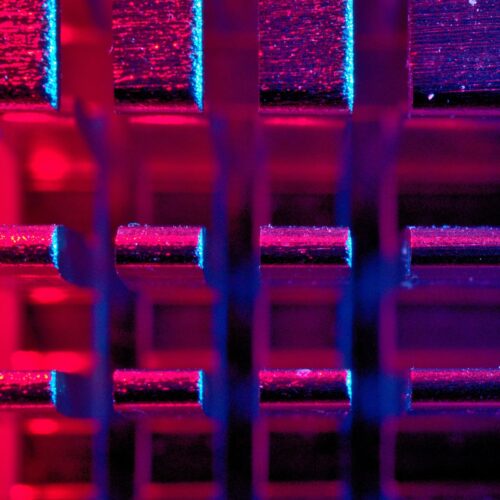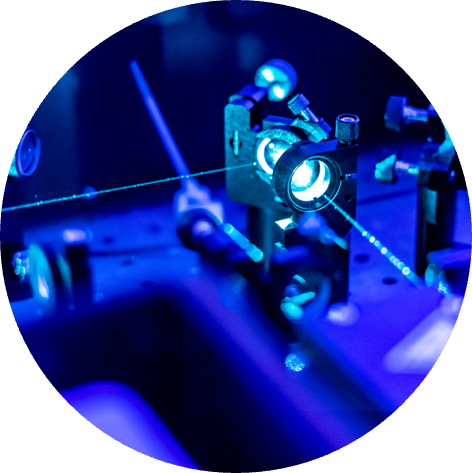Technology overview
The qubits in an ion-trap quantum computer are spatially confined charged particles, which are suspended in space using a combination of radio-frequency and electric fields. Qubit states are generated using two electronic levels of the ion, such as the ground state and an optically excited state, or two hyperfine electronic levels, depending on the atomic species being used and the wavelength of laser light available. Single-qubit operations are achieved through optical excitation between the two states, while two-qubit gates exploit optics or microwaves to generate interactions between motional modes of the ions.
As well as being a relatively mature qubit architecture, ion-trap quantum computing offers several key advantages:
- Long coherence times and gate fidelities of more than 99% for both single-qubit and two-qubit gates. The creation and readout of quantum states can also be achieved with high fidelity
- Relatively simple fabrication processes, and can exploit ongoing developments in enabling technologies such as high-stability lasers and cryogenic systems
- The same control processes can be used to manipulate all of the ions, since they are all identical
- The ions can be shuttled around the trap to communicate information about entanglement and the quantum state, plus the ion state can be coupled with photons to transfer entanglement. All-to-all connectivity is also possible.

Scaling challenges
Creating larger assemblies of ion traps on a single wafer is also limited by fabrication technologies as well as anharmonicity in the trapping potentials, and achieving connectivity over physically different chips or traps remains a major challenge. Current systems require a large number of discrete optical components, requiring the development of Integrated photonics systems such as chip-based optical detectors.
The linear chains of ion traps that can be created relatively easily offer limited connectivity, and it remains difficult to create 2D arrays. Shuttling the ions for all-to-all connectivity requires complex junctions that are hard to fabricate reproducibly, while the photonic interconnects needed to transfer entanglement also present a fabrication challenge. For two qubit gates, it is difficult to control the long-range spin-motion coupling with microwaves.

NQCC activities
The near-term plan is to build two ion-trap cryogenic test systems that exploit a modular design for greater flexibility. The aim is to create a product-like system that can support a range of test traps and that can be easily adapted to exploit advances in the field.
The first ion-trap chip is a surface-geometry trap supplied by the University of Oxford through the NQCC’s partnership with the Quantum Computing and Simulation Hub. This chip, which has already been characterised by the Oxford team, will make it easier for us to develop and test the modular sections of our complete system.

Latest progress
An optics lab has been established for us to build our first test system, which will exploit calcium-43 as the ion species and microwaves for gate control. We have installed a custom cryostat that optimises optical access and provides the large numbers of electrical connections needed to control individual ions. We are currently focused on building optical paths that efficiently deliver laser light to the ion chip, exploiting a modular approach to offer greater flexibility and so extend their useful lifetimes.
Engineering teams within STFC have helped us to manufacture key components, establish cleanrooms for testing, and install custom laser-safety controls that avoid the need for personal protection equipment. We are also working with our colleagues in the Software and Control Systems team to develop a scalable control system for the experimental platform. We have adopted an agile methodology for implementing our software and control work packages, and as our effort progress we are producing a library of supported software, control equipment and flexible laboratory tools.

Collaborative research
We are partners in two collaborative projects supported by Innovate UK:
- M-PIT, led by ColdQuanta, is developing a new method for producing commercial ion-trap systems that will exploit the company’s miniature vacuum packaging. Our team will investigate use cases for miniature packaged systems and provide input into the design and development process.
- INTERCOM, led by NuQuantum, is creating a device that enables quantum information to be transferred between remote ion traps through photonic links. The solution exploits the confinement of light between two micro-mirrors in a resonant optical cavity, ensuring a strong interaction between the ion (or atom) and the optical field. The project will deliver a robust, turn-key cavity interface that allows scalable integration in ion- and atom-based quantum networks.




